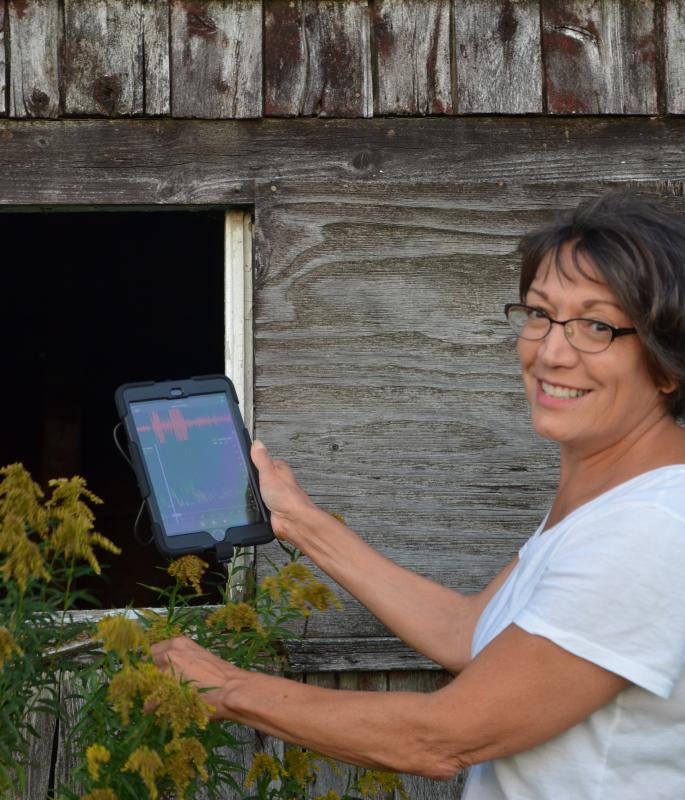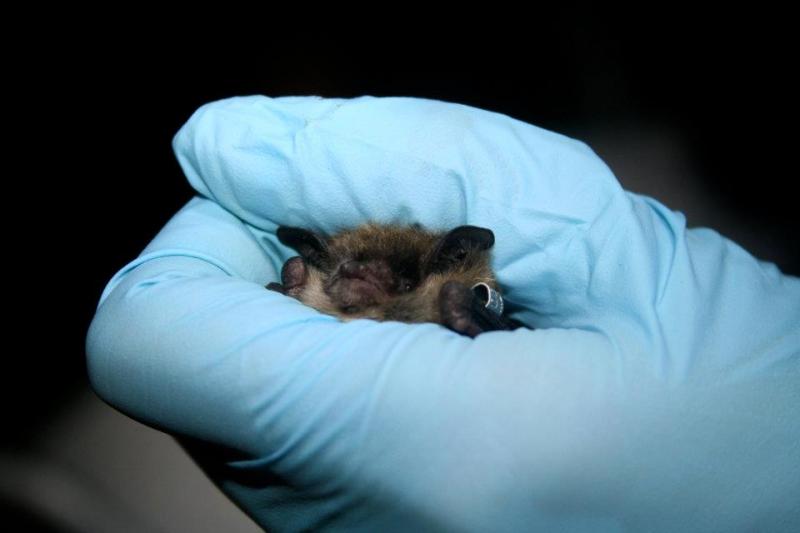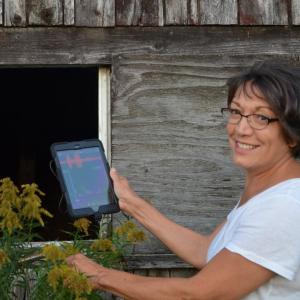Bats! Doing a world of good, but so misunderstood
 Annie Kassler and bat spectrometer investigate an old Rockport barn. (Photo by Lynda Clancy)
Annie Kassler and bat spectrometer investigate an old Rockport barn. (Photo by Lynda Clancy)
 A long-eared bat flying over a churchyard. (Colored wood engraving by Josiah Wood Whimper)
A long-eared bat flying over a churchyard. (Colored wood engraving by Josiah Wood Whimper)
 Researcher holds little brown bat (Myotis lucifugus) (Photo courtesy U.S. Fish and Wildlife Service researcher Ann Froschauer)
Researcher holds little brown bat (Myotis lucifugus) (Photo courtesy U.S. Fish and Wildlife Service researcher Ann Froschauer)
 Annie Kassler and bat spectrometer investigate an old Rockport barn. (Photo by Lynda Clancy)
Annie Kassler and bat spectrometer investigate an old Rockport barn. (Photo by Lynda Clancy)
 A long-eared bat flying over a churchyard. (Colored wood engraving by Josiah Wood Whimper)
A long-eared bat flying over a churchyard. (Colored wood engraving by Josiah Wood Whimper)
 Researcher holds little brown bat (Myotis lucifugus) (Photo courtesy U.S. Fish and Wildlife Service researcher Ann Froschauer)
Researcher holds little brown bat (Myotis lucifugus) (Photo courtesy U.S. Fish and Wildlife Service researcher Ann Froschauer)
As Halloween approaches, the night sky becomes a little darker. The air creeps with those dreaded spirits, dead and alive. The cold rush of air suddenly chills one side of the body. That shadow where one ought not be.... A movement from the periphery of the eye startles the senses. Bats! you tell yourself.
But no. It probably wasn’t. Instead of spiraling from the cave roofs or the attic rafters, certain species of bats are spiraling out of existence in Maine, as they are throughout the rest of the eastern U.S. For humans set on enjoying outdoor evenings without the incessant ear-buzzing, skin-slapping, insane asylum-sending mosquitoes, a world without bats would be devastating.
A single Little Brown Bat, one of Maine’s eight species, can eat up to 1,000 mosquitoes in a single hour. Bats also eat the flying bugs and beetles that lay worms on corn, broccoli and other vegetables and fruit we are trying to grow, thus saving the agricultural industry an estimated $23 billion a year.
The bat comprises 1,331 species and is the only migratory flying mammal in the world.
Along with pest control, bats also serve as pollinators of bananas, mangos, and cocoa. They are the sole pollinator of the agave plant (think tequila), and they distribute seeds in open areas. Fruit bats are responsible for 98 percent of rainforest regrowth.
Yet these bats, known for their 10-30 year life span, are fighting for their existence against illness (White Nose Syndrome), human aggression, predation, and habitat destruction. A U.S. Geological Survey study said 1,320 metric tons of insects would not be eaten in New England alone this summer because of the bat population decline.
Maine’s Little Brown Bat has seen a 97 percent decline in population. White Nose Syndrome, a fungus that can be lethal in very small amounts, has killed an estimated 6 million bats. It is estimated that wind turbines alone, with the pressure change between the blades, has killed 1.7 million bats in the U.S. and Canada.
The last week of October is National BatWeek. Saturday October 31, is Bat House Building World Record Day.
Events are taking place across the globe to set a Guinness Book World Record for the most bat houses built in one day.
Locally, there is a day of events at the Coastal Islands National Wildlife Refuge Visitors Center in Rockland from 10 a.m. to 3 p.m.
From 10 a.m. to noon, Brian Lies, children's author and illustrator of the New York Times best selling series on bats, will be reading from his stories and signing books for sale.
There will also be bat crafts and activities. A one-of-a-kind bat house hand-painted by Brian Lies will be available through silent auction.
At 2 p.m., join Annie Kassler, local bat educator, for her popular bat presentation and slide show. Throughout the day, bat houses will be assembled from kits that have been produced by the students at the CHRHS shop class.
To reserve a bat house or for more information, call 594-0600x5 or fomsi@maineseabirds.org
Coastal Islands Wildlife Refuge Visitors Center, 9 Water Street, Rockland.
“They are gentle creatures,” said Annie Kassler, a broker with Camden Realty who became a bat advocate after renovating her lakeside camp.
“They do not chew wires or wood in your house,” she said. “They do not make the holes in the walls. They do not all have rabies. Worldwide, less than one half of one percent has rabies. It is possible to live in harmony with bats, especially once you realize all the good they do.”
Annie is one of four volunteers working in the field, collecting data for for the University of Maine’s Department of Wildlife Ecology. Equipped with an iPad and an echolocation monitor, she is helping identify bat colonies — or what’s left of them — throughout the state.
“Bats make calls as they fly and listen to the returning echoes to build up a sonic map of their surroundings,” according to the Bat Conservation Trust. “The bat can tell how far away something is by how long it takes the sounds to return to them.”
But bats are rapidly succumbing to White Nose Syndrome, a soil fungus that affects only bats. It was detected in a New York cave in 2006, believed to have been introduced in North America by European spelunkers. The fungus spreads like wildfire, is now in 26 states and five Canadian provinces, and preys on bats as they hibernate, a time when their immune systems are normally resting. It is a cascade of debilitating effects that kills the bats. Trying to stave off the disease, they burn through their fat reserves and starve, or they leave the cave to look for food and freeze to death.
There is a collaborative governmental, academic and nonprofit effort to research and stabilize the bat population. Bats only have one baby, or pup, per year, making population recovery slow.
Researchers are identifying bacteria and fungi that inhibit the disease, as well as developing vaccines and other treatments that are showing promise. It will likely take a combination of effective treatments to reduce White Nose Syndrome.
In Maine, the Northern Long Eared and Little Brown bats are on the state’s Endangered Species list. But there are not many of these bats left.
“I want people to know that every bat counts,” said Annie. “I still hear from people who will kill a bat that comes into their house. There is just no need for it. If you have a stray bat in the house, open the door. If it needs to be removed, put gloves on, place a tupperware or container over the critter, slip a magazine or something stiff underneath, take it outside and let it loose.”
Resist the urge to swing the broom or tennis racket. Bats are gentle creatures and not interested in you. Nor, are they blind.
“They see perfectly well,” said Annie, who got interested in bats some years ago when she renovated her camp. When she took some of the windows out, the bats moved in.
“I went there for my week off and there were a few bats living inside. I opened the door to let them out, then 5,000 mosquitos came in. The bats didn’t need to go out.”
She got used to them.
“I thought, I should learn something about them. Once I started, I wanted to learn everything.”
Now, Annie is a speaker for Bat Conservation International, giving talks and workshops throughout Maine about bats. It is her passion and she knows what she is talking about. She may be contacted for presentations at annmariekassler@gmail.com.
“Bats are vital to the health of the planet,” she said.
Reach Editorial Director Lynda Clancy at lyndaclancy@penbaypilot.com; 207-706-6657
Event Date
Address
United States































